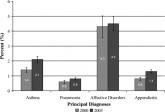Article

Persistent gap of incremental charges for obesity as a secondary diagnosis in common pediatric hospitalizations
- Author:
- Susan J. Woolford, MD, MPH
- Achamyeleh Gebremariam, MS
- Sarah J. Clark, MPH
- Matthew M. Davis, MD, MAPP
Article
Interhospital transfer of critically ill and injured children: An evaluation of transfer patterns, resource utilization, and clinical outcomes
- Author:
- Folafoluwa O. Odetola, MD, MPH
- Matthew M. Davis, MD, MAPP
- Lisa M. Cohn, MS
- Sarah J. Clark, MPH
Article
Pediatrician and Family Physician Agreement with and Adoption of Universal Hepatitis B Immunization
- Author:
- Gary L. Freed, MD, MPH
- Victoria A. Freeman, RN, DrPH
- Sarah J. Clark, MPH
- Thomas R. Konrad, PhD
- Donald E. Pathman, MD, MPH
Article
Breast-Feeding Education and Practice in Family Medicine
- Author:
- Gary L. Freed, MD, MPH
- Sarah J. Clark, MPH
- Peter Curtis, MD
- James R. Sorenson, PhD
